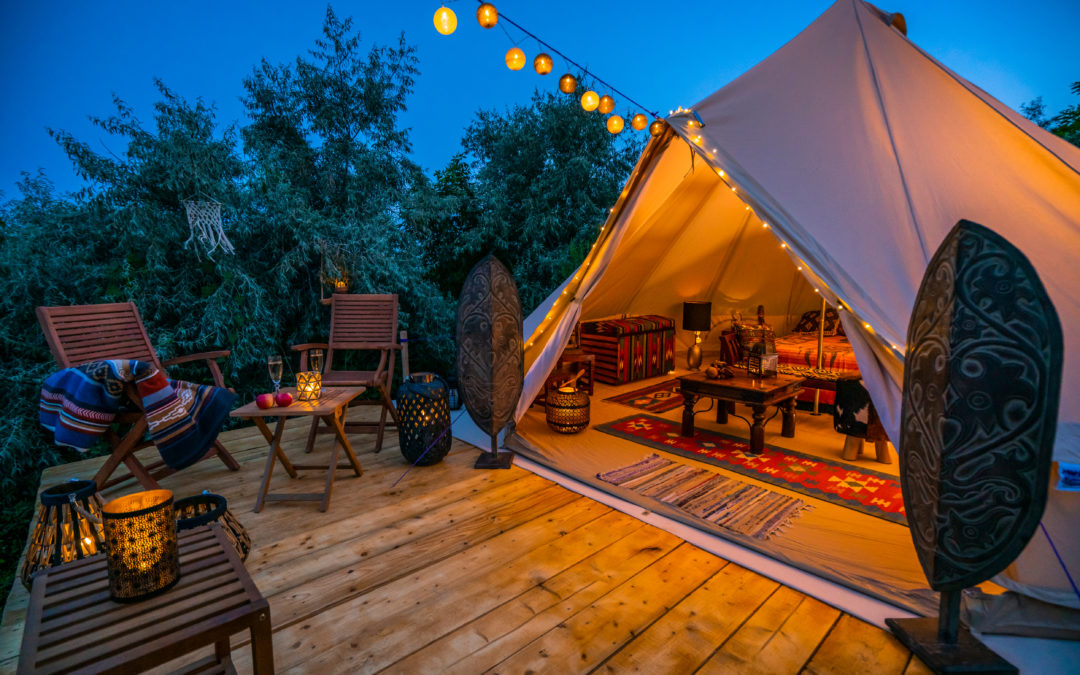
by The Goat | Sep 6, 2020 | Glamping
As summer comes close to an end, you may be looking to take one more vacation before the colder weather starts. How does camping with all the luxury of home sound? If you are wanting to get away from it all, without getting away from it all completely, glamping may be just the thing for you. Glamourous camping, most popularly known as glamping, involves traditional camping with all the comforts of home. Here are a few other benefits of glamping to keep in mind:
1. You take home with you
Glamping means you are camping without the challenges of regular camping. It means no more sleeping in a tent that has no room. No more sleeping on the ground. No more awkward bathroom trips. With glamping, you can camp in a real bed so you can get a good night’s sleep. You also get way more space with all the everyday conveniences (such as outlets) on hand.
2. Beautiful locations
If you have resisted the idea of camping because you prefer the luxury of a hotel, you may love the idea of glamping. Why? You get to experience the outdoors in a way that a hotel can never give you. You will be steps from a private beach or mountain range overlooking a scenic view. You will be immersed in nature in a way you would never get with a hotel.
3. You won’t break the bank
Although it sounds like it can be more expensive, glamping is much less costly than staying at a resort or hotel. There are way more overhead costs with a resort, but with glamping, you are more likely to support the local community. Also, with glamping, you will want to stay longer. Thanks to the comforts of home, you won’t have to worry about undercooked food, cold showers, and smelly bathrooms.
4. You reduce your ecological footprint
Glamping gives you a new appreciation for nature. Large resorts are difficult to build and often destroy surrounding land in their construction phase. When it comes to glamping, it can happen anywhere. It also has minimal constructions and requires fewer resources. It leaves a smaller footprint because the cabins, tents, yurts, and huts don’t have as much assembly.
5. You take something great, and make it even better
The outdoors are great, camping is a fantastic activity. But sometimes, you just want to chill, and real camping can be quite a lot of work, especially if you don’t have it down to a science.
What better way to vacation this summer than by glamping in the outdoors. You get to immerse yourself in the nature around you without having to rough it. Contact Canyons and Chefs for our chef-driven luxury expeditions.

by The Goat | Aug 10, 2020 | Cooking
Not all gifts are created equal, and some of the most memorable and life altering gifts are not contained within the confines of a neatly wrapped box. As we find ourselves searching for ways to connect with ourselves, our family and friends, and to the world around us, it makes sense that we turn to idea of giving experiences, rather than objects, as perfect gifts for any occasion.
Gifts of experiences are completely customizable, can fit any budget, and provide highly personalized activities that can be singular or group oriented. Whether you choose to give a hobby related excursion or provide a new adventure altogether, you can rest assured that your gift will be one of a kind.
Wine & Food Tasting
No matter where you live in the country, there is food to be explored in your area. In Seattle, its a Pike Place Market food tour, in Baltimore is a food and wine pairing by a local chef, in a coastal southern town it may be tasting fresh catches from the sea dockside. Wherever you, or your loved one lives, there is undoubtedly a food exploration excursion to be enjoyed. This type of gift creates a deeper appreciation of the local area, and can inspire future outing ideas for everyone involved.
Fun In Learning
Oftentimes people have interests that they would love to become involved in but fail to follow through with the steps necessary in order to do so. Providing the course, or a class, or participation in an educational experience can open many new doors and fulfil lifelong dream. A class in flyfishing, cooking, sailing, music, and any hobby you can think of can be turned into a thoughtful gift that can even be shared with others in a group event.
A Special Touch
Upgrade your family or friend’s weekend getaway by elevating your outdoor experience. While glamping and guided tours have become increasingly popular ways of hitting the trails, many times you are spending your time with others who have also booked the trip. For a truly personal and inspiring adventure, consider taking a tour of the beautiful Grand Canyon with Canyons And Chefs for an experience of our beautiful country like no other. These guided tours culminate with professional chef prepared meals, meaning all that you and your guests have to do is take it all in and enjoy. This type of experience is perfect for girls trips, family vacations, or couples romantic excursions.
The Gift That Keeps On Giving
Creating memorable, one of a kind moments for ourselves and the ones we love provides us with more opportunities to strengthen bonds and develop lifelong memories. Almost any experience can be turned into a gift for anyone and for any occasion, it is the ultimate gift that keeps on giving.
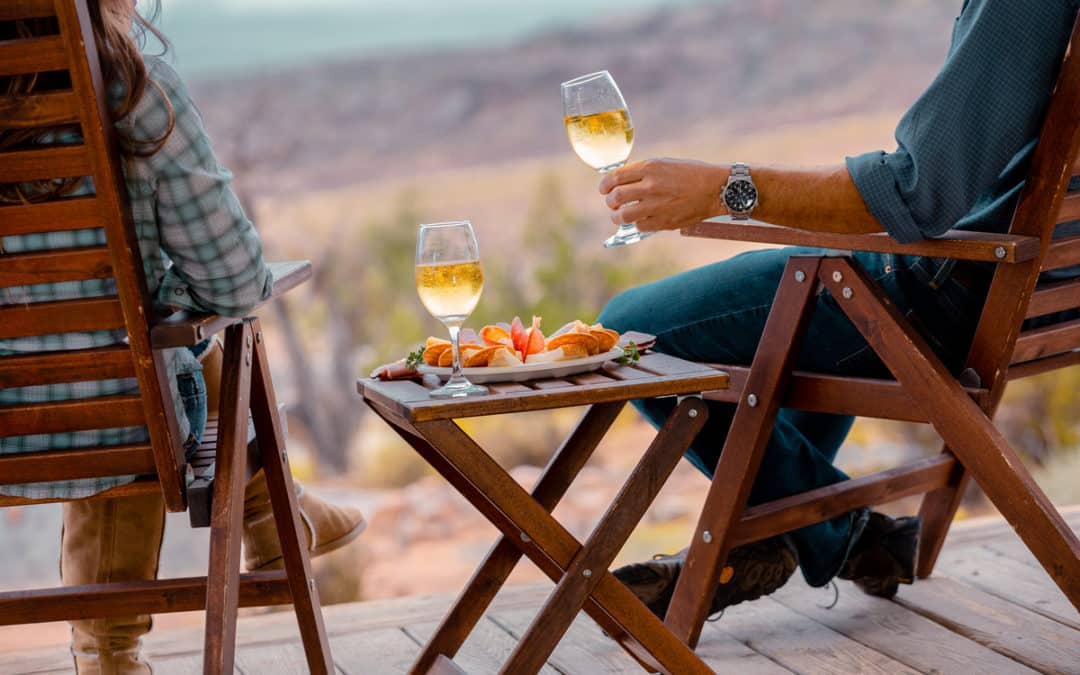
by The Goat | Jul 13, 2020 | Glamping
Glamping is a popular buzzword in the outdoor realm, and for good reason. It’s the hottest new trend in getting out and enjoying nature. For decades proceeding, camping had a rather vast spectrum that ranged from minimalists who slept on the ground in remote areas to RVers who took advantage of the many RV parks available. Glamping is now pushing the envelope when it comes to a posh experience and luxurious camping accommodations. Now, you and a group of your best friends, lovers, or revelers can access the remote, spectacular areas while still enjoying some of the creature comforts you can find at home, or even upscale hotels and resorts.
Follow along as we delve into the wondrous world of luxury, style, and comfort, all in the wondrous world that is our natural backyard!
What is Glamping?
The word itself really isn’t surprising. It is a mash-up of the words “glamour” and “camping.” Just like traditional camping, glamping has a spectrum. On one end, you have elevated campsites that feel more like home than a tent, and on the other, you have uber-luxe settings that are actually more like five-star hotel suites found in the great outdoors.
Much like regular camping, glamping is essentially what you make it. For some, glamping may be as simple as bringing along a subwoofer for your Ipod, while for others glamping may be essentially an actual five-star resort adjacent to a wooded area, with perhaps a fire. However, true glamping is simply an ultra-elevated outdoor experience.
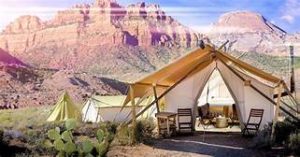
Glamping vs. Camping
One of the biggest differentiators in these two experiences is your overall comfort level. With glamping, you are semi-roughing it. With that being understood, there are no hard-and-fast rules. If you decide to book a glamping getaway, the provider you go through may provide you with a campsite and offer you various luxuries, such as a private shower, closet to hang your clothing, and even a private chef for amazing meals.
However, if you take the DIY approach to glamping, it may just mean a larger tent, more luxurious mattress, or even using gourmet cookware. More decorative campsite touches are also a part of the fun of glamping. You can think of it as decorating buy using an outdoorsmen’s sensibility. If a string of LED flamingo lights, an elegant camp chair, an artsy rug, or even a French coffee press is what speaks to you, then it is a definite candidate for your glamping experience.

A First-Timer’s Guide to Glamping
If glamping is something you want to try, there are several options to consider. For example, you can choose an all-inclusive glamping getaway. If you go the all-inclusive route, you may find it’s expensive; however, having a professional plan all the details of the trip reduces the stress on you. There are numerous resorts and purveyors of glamping experiences. Glamping resorts tend to be more of closed-in experiences closer to staying at a hotel in nature, whereas expedition outfitters tend to take inspiration from resorts and take that into private backcountry surroundings.
Another option is to book a glamping rental. You can think of this as a rental service for yurts, but you can find other options, too, such as tiny houses, trailers, and tents. Chances are there are more glamping options in your area than you realize. Indeed, simply booking a yurt close to a National Park or natural beauty is sort of a hybrid between full-scale galmping and DIY glamping. Your Yurt and experience is basically what you make it.
You can also become a DIY glamper. This means that you take the entire experience into your own hands and take steps to elevate and glam-up your camping excursion. This may take some careful planning, but it will be worth it in the long run. Fancy tent? Cheffy meals? Trailer-towed backcountry hot tub? The choices are yours!
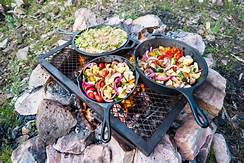
Are You Ready to Go Glamping?
As you can see, there is quite the appeal to glamping. If you want to make the most of your adventure, be sure to keep the tips and information here in mind. It will pay off and ensure that you and your entire family have a great experience, regardless of where you go or what you do. Straddling the two worlds of wilderness adventure and front-country creature comfort is the very essence of human evolution: from survivalist to tourist!
Guided Glamping Expeditions
Hiking and exploring our National Parks or any beautiful landscape is a special experience. Although it is possible to see these places yourself, hiring a guide outfitter is a great idea. For instance, guiding services provide logistical support, and plan everything for your best possible trip. They provide a great safety net on the trail, and are trained in backcountry medicine. Above all, they provide a depth of knowledge of the region that turns a walk into a true adventure.
Canyons and Chefs provides all of the support you need, and pairs that with professional chefs and expert geologist/guides. Our meals use fresh ingredients and are inspired by local farms, culture, and cuisine. We utilize a mobile professional kitchen as a backbone for cooking over the fire. Furthermore, we provide top-of-the-line gear and passion for the places we explore. Summed up, you can explore these wild places, but going with Canyons and Chefs can create an even more memorable experience. Don’t be shy, and call us!
Read our blog!
For adventure Chef-Driven Outdoor Experiences, see our epic tours in Grand Canyon, Utah, and Arizona!
Follow us on Facebook and Instagram
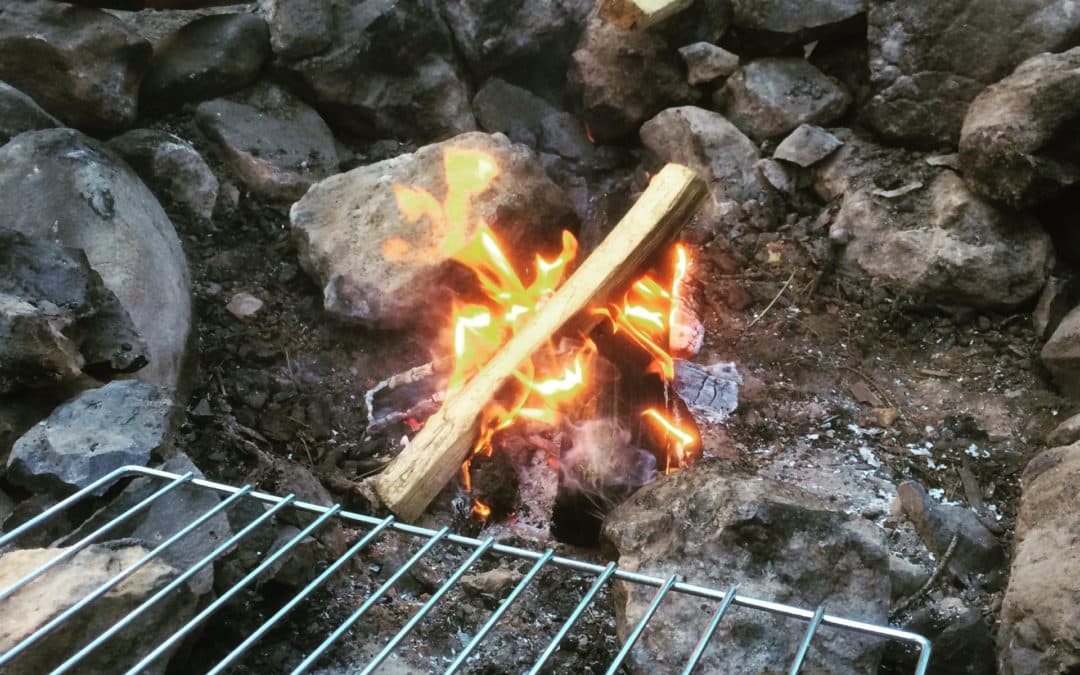
by The Goat | Jun 3, 2020 | Cooking, Dutch Oven Recipes, Food
Canyons and Chefs Most-Loved Backcountry Recipes

A word from the Fireside Chef
In my years of travel and travail through mountains, deserts,Michelin- starred restaurants, backyard barbecues, culinary schools, canyons, parks, summits, and walk-in refrigerators, I have learned one thing: Cooking matters. This is an overarching idea that covers many different philosophical subsets: good food matters, good company matters, happiness matters, smell matters, taste matters, sight matters, texture matters, memories matter. All of this coalesces into why food is so important in our lives. It is not simply a vehicle for sustenance. The renewed farm-to-table food movement of the past decade has proven that human nature rises above TV dinners and microwaved hot dogs. Internally, we are all chefs, and we all crave to cook and eat food that is fresh and has some measure of humanity within it. Being phased out are the days of the industrialized food conglomerate of processed “cheese” and mystery meat patties, and back are the days of fresh produce, locally sourced meats, artisan breads and cheeses, and the rekindling of the Farmer’s Market.
Nowhere can this movement be found more evident than when one cooks in the outdoors. Gone are the days of beanie-weenies and food-on-a-stick, and in is the day of the Fireside Chef: a person who cares about the food they are serving, a person who has a deep connection with their surroundings, a profound respect for nature, and an understanding of how the stars have aligned so that we may be here to create and enjoy gorgeous and delicious food. If you can, take some time to ponder the profundity of geologic time and the steps that were necessary throughout the course of history to put this power into your hands. Cook on my friends: May your coals be hot, your drinks be cold, your company welcome, and your experienceunforgettable.

Enjoy our 5 most-loved campfire/dutch oven recipes!
*House Seasoning = 1 part Kosher Salt, ¼ part coarse-ground black pepper, Dash of mesquite

>Beer-Braised Beef Short Ribs with Caramelized Apples, Bacon, and Sage
Short ribs are the second pair of ribs on a cow that lie justbeneath the main pair. They have a rich flavor and tender nature, with an extravagant amount of meat for such a small bone.
1 lb. bacon, chopped
3 lbs. (12) short ribs, trimmed
½ cup bourbon
1 yellow onion, peeled and chopped
2 carrots, peeled and chopped
4 cloves garlic, peeled and chopped
4 apples, peeled, cored, and chopped
4 cups beef stock
1 cup apple juice
¼ cup cider vinegar
1 12 oz. can lager-style beer
10 leaves fresh sage, chopped
Crisp the bacon in a dutch oven until golden brown. Remove from the pot, and reserve ½ of the fat in the pot, discarding the rest (it’s great to save for later). Season the short ribs with house seasoning, and add to the pot, searing until browned on all sides. Remove ribs from pan, and deglaze with bourbon, reducing by ½ . Add more fat, and add onion, carrots, garlic, and apples. Saute slowly until golden brown, add back bacon, and cover with beef stock, apple juice, and vinegar. Add chopped sage leaves, cover the dutch oven, and place in the simmer pit for 4-5 hours. Remove from the pit and take out the ribs. With a slotted spoon, fish out apples, carrots, onions, garlic, and sage and spoon over ribs. Pour a small amount of braising liquid over the ribs and serve.
>Sonoran BBQ and Pepper Bacon Burger
This one could really be called the Sonoran Smokehouse, as it is truly our high desert version of a burger that can be found on burger joint menus. Smoky, delicious, just what you need.
For the Burger:
1 lb. 80/20 Ground Beef
1 tbsp. Worcestershire sauce
1 tbsp. Dijon mustard
For the BBQ Sauce:
1 c. Good-Quality Ketchup
½ c. Apple Cider Vinegar
⅔ c Light Brown Sugar, tightly packed
¼ c worcestershire sauce
¼ whole-grain mustard
2 Chipotle Peppers in adobo, finely minced
1 c. beef stock
House Seasoning, to taste
Combine all ingredients, whisking together. Pour into a saucepan and simmer over low heat heat until it reaches a thickened, saucy consistency. Cool.
Toppings:
2 Jalapeno-Cheddar Burger Rolls
8 slices pepper bacon
2 Poblano peppers, roasted, skinned, and seeded
4 slices smoked gouda
2 leaves Romaine lettuce
4 slices Roma tomatoes
6 pickle chips
Fry the bacon until golden brown and crispy. Liberally season the patties with house seasoning and place on a hot, oiled grill directly over the coals. Rotate for grill marks, and flip when edges are crispy and browned. Place peppers, then bacon on patties, and top with smoked cheddar cheese. While cheese is melting, toast buns until crispy, then remove from the grill and slather with sauce. When cheese is melted, place the patties on the bottom bun, and garnish the top bun with lettuce, tomatoes, and pickles.
>Grill-Blackened Halibut with Roasted Garlic and Chile Salsa
Blacking spice is typically used when searing fish or meat with oil. Halibut is a flaky whitefish that stands up well to the bold flavors in the blacking spice and salsa. The salsa for this recipe takes some time, so it is wise to plan ahead.
For the Blacking Spice:
2 tsp. paprika
1 tsp. cumin
1 tsp. chili powder
2 tsp. House seasoning
1 tsp. onion powder
½ tsp. dried thyme
½ tsp. Mexican oregano
For the Fish:
4 6oz. Alaskan Cod fillets, skinned, scaled, and pinboned
Blacking Spice
Apply desired amount of spice to cover the entire fillet. Add to hot, very well-oiled grill (cod may stick if grill is not properly heated and seasoned) over the coals, turning to obtain deep grill marks until the blacking spice is black. Transfer to indirect heat side, and cook through.
For the Salsa:
1 whole head of garlic, cut off bottom so that cloves are exposed
1 tsp olive oil
2 poblano chilies, roasted, seeded, and chopped
2 tomatoes, halved, grilled, and chopped
1 small red onion, halved, grilled, and chopped
2 limes for juicing
1 bunch cilantro, chopped
House seasoning to taste
Enclose garlic with oil in aluminum foil, place on the grill over low heat for 45mins-1hr.
While garlic is roasting, roast chilies according to procedure, and grill onions and tomatoes until blistered with grill marks on all sides. Remove everything from the grill, and let cool slightly. Remove garlic from foil, and squeeze cloves out of skins onto a cutting board and chop roughly. Chop your remaining vegetables, and place in mixing bowl. Finish with lime juice and chopped cilantro, and season to taste with house seasoning. The salsa should be chunky. Spoon over cooked fish.
>Spicy Pistachio-Rubbed Elk Tenderloin with Savory Cactus-Blueberry Compote
This is a dish we sold quite a bit of at an acclaimed restaurant in Vail, CO during ski season. The tart spicy-sweetness of the compote cuts nicely with nutty, spicy pistachio rub, and the unctuous, earthy flavor of elk.
4 8oz Elk Tenderloin Steaks
Pistachio Rub:
1 C. Pistachios, shelled and ground into a semi-fine powder
1 tsp cumin
1 tsp brown sugar
1 tsp chipotle powder
1 tsp ancho powder
½ tsp mesquite powder
2 tsp kosher salt
1 tsp ground black pepper
For the Compote:
12 oz. organic blueberries
3 fresh nopal cactus paddles, spines removed (have the butcher do this), chop to size of berries
1 chipotle pepper in adobo, minced
2 tbsp sugar
1 c. beef stock
1 tbsp lime juice
Begin the compote first. it will take at least one hour. Roll the blueberries in the sugar and set aside. Place your small dutch oven over the fire and heat until a drop of oil produces smoke. Add the cactus and peppers, season and saute until beginning to brown. Add sugared blueberries, reduce heat (move away from coals/flames), and saute until blueberries begin to break down and turn slightly syrupy. Add in beef stock and simmer until mixture becomes slightly thick, coating the back of a spoon. Add lime juice, and season to taste. Set aside, but keep warm.
Rub the elk steaks liberally with the pistachio spice. Be sure your grill is hot, and your coals are gleaming. Oil the grill, and place steaks directly over the coals flat-side (butchered-side) down. Rotate 45 degrees to obtain grill marks, then flip, obtaining grill marks on the other side. Cook to desired temperature (120 is rare, 160 is well done). Dress with compote.
>Desert Canyon S’mores
Whoever conceived of this toasted mallow and chocolate sandwich should be given the Congressional Medal of Honor. Spoiler alert, it was me! This recipe makes it true canyon country-style with a sweet and spicy prickly pear sauce, which is slow-simmered and used to dress the chocolate-marshmallowy goodness.
Stash of Graham Crackers
Stash of Chocolate Bars
Stash of Marshmallows
Prickly Pear Sauce
1/2 c. Prickly Pear Syrup (Cheri’s Desert Harvest is our go-to)
2 mangoes, peeled, cored, and rough chopped
1 c. pomegranate juice
1 tsp dark brown sugar
1 habanero pepper, seeds removed, finely minced
House seasoning to taste
Over low heat add mangoes to dutch oven or small saucepan with a small amount of oil. Add sugar and stir until begging to brown. Add pepper and continue to saute until brown and caramelized. Cover with pomegranate juice and simmer until reduced by ½. Add prickly pear syrup, season to taste. Enjoy!
Bonus Side Dishes
>Dutch Oven Cauliflower au Gratin
This is an incredibly flavorful, comforting and easy dish; especially under the stars, by the fire with a glass of wine or snifter of fine scotch. Be careful of heat control, you do not want to burn the bottom.
2 heads fresh cauliflower, broken into reasonably-sized pieces
2 cup heavy cream
2 cups good-quality cheese (none of that yellow stuff; I like a blend of smoked gruyere and parmigiano-reggiano)
House Seasoning, to taste
Good quality hot sauce to taste (Arizona Gunslinger is quite tasty)
Oil for cooking
Place dutch oven over the fire and heat. Toss cauliflower in oil, and season with house seasoning. Place in the duthc oven and cook slowly, until caulilfower florets have begun to take on a deep brown (this will take 30-45 mins). Pour cream over the cauli, and the cheese, and cover with top. Put on a relatively cool part of the grill, so as not to burn. Check and stir, if necessary. The gratin is done when all the cheese is melted and has thickened the cream, perhaps 30-40 minutes depending on the grill temperature. Season to taste and serve.
Marinated and Grilled Asparagus
Simple, easy, and delicious. Asparagus is one of my favorite vegetables, and grilling it gives a wonderful, smoky flavor that pairs well with almost anything.
3 Bunches Asparagus (good, fat ones), trimmed
3 tbsp extra virgin olive oil
3 cloves garlic, thinly sliced
1 tbsp soy sauce
1 “inch” of ginger, grated (this should equal 1 tbsp)
Combine all ingredients and let stand for at least 30 minutes, but no more than 4 hours. On a good, hot grill, lay down the marinated stalks, do not allow them to overlap. Grill for 5-10 minutes depending on thickness. The stalk should be tender, still snap when bent.
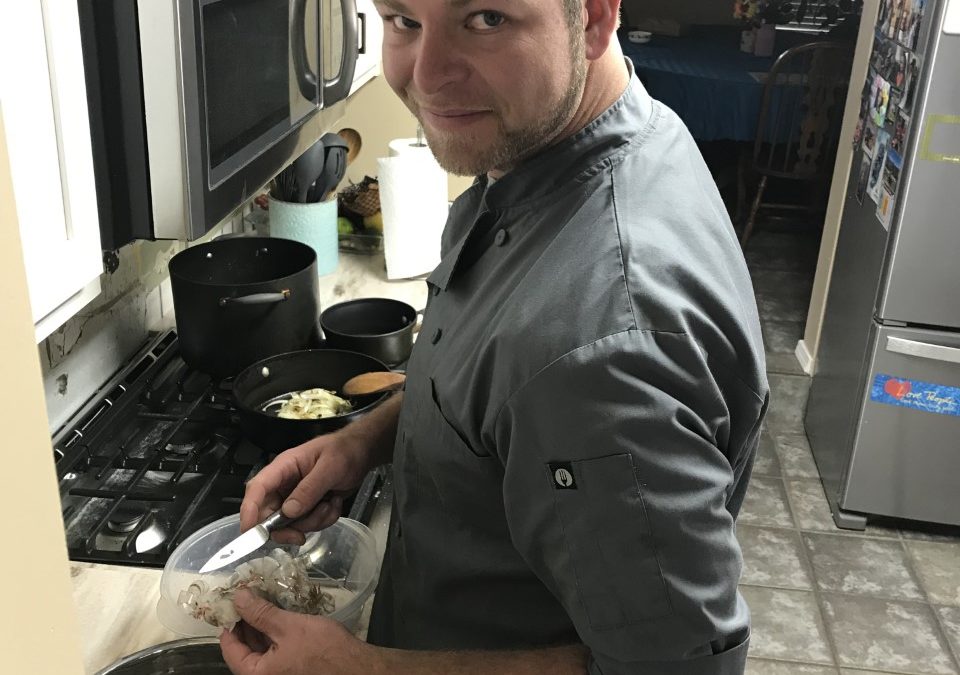
by The Goat | Jun 2, 2020 | Cooking, Food
A Day in the Life of Chef
People ask me from time to time, what’s it like to be a chef? That’s a complicated and deep answer, worthy of more than just the stock “it’s cool” answer. You work long, odd, hours, oftentimes for underwhelming pay and an overwhelming work load. Your environment is hot and filled with dangerous hazards such as razor-sharp knives, searing hot oil, and unpredictable personalities. The stress level during a busy service in an acclaimed restaurant can be off-the-charts, complete with angry cooks, frustrated servers, and a monstrously hectic environment. Being a real chef is very little like it appears on the Food Network, and even less than it looks like in a culinary school brochure.
Being a chef, a real actual chef, is not for the faint of heart. It is for those with thick skin, laser-like focus, an unwavering work ethic, and a serious mind. It is often far less like being a rock star, and far more like being a factory worker. But if you ask most of us, we wouldn’t trade it for anything else. It’s in our blood, it consumes us, and putting out that next stunning plate is what drives us. The line is our operating room, our court room, the knife our scalpel, the plate our artist’s palette, the presentation our architects blueprint, the foundation of flavor our all-consuming master work.
Is Being a Chef a Good Career?
Sure! If you love food, have a passion for art, creativity, and enjoy the rush of adrenaline produced from a 300-cover Friday Night in a professional kitchen, then this is the career for you. It can be a highly rewarding career; making people happy with your art is a feeling like no other. There are also many career avenues that can be taken as a chef. The most obvious, of course, is to work in restaurants with the eventual goal of owning your own place. This is the goal and aspiration for many young chefs, but it is far from the only path. For example, the path that I’ve taken is quite unique. I’ve created a company that brings together my two worlds; fine food and outdoor adventure. Of course, it took me many years to get here, but this is no different than most chefs who want to get ANYWHERE.
There are myriad avenues available to you. You can become a food writer, for instance. This is becoming a far more competitive field with the advent of the food blogger, but it is a tremendous avenue, nonetheless. In fact, you can do nearly anything you want as a chef. You are, after all, a provider of food and good times. This can be a widely-needed skill set. Cooking is a skill set that will never go out of style, will never be passe, and will always be needed. Being able to conceptualize and execute a delicious meal is something that will be with you everywhere you go, and will always be in demand. As a chef, do not confine yourself simply to the idea of working in a restaurant. Create your own identity, whatever you do.

So, are you going to answer the question?
The answer is yes, being a chef can be a great career. However, don’t be fooled by hype. It is just like any other career; fraught with pitfalls and pratfalls, filled with horrible and demanding bosses, monotony, fear, deep anxiety, and whatever else you can think of. In fact, many chefs suffer from mental health and addiction issues, the pay for the first several years of your career is likely to be minimum wage, and you are expendable at a moment’s notice (no matter what you think of yourself). Not feeling well? Tough, go to work. Broke up with your girlfriend? Tough, go to work. Chef’s screaming at you? Tough, take it or be fired. Want that vacation? Ha, good luck!
Beware that the chefs you see on TV are but one-in-a-million. For every Gordon Ramsey or Woflgang Puck there are 10,000 Bill Woodses. Who’s that, you ask? Nobody, just me. Somebody who “made it”, but is still essentially anonymous. For every Bill Woods, there’s another 10,000 nobodies who may never make more than minimum wage, toiling in failing restaurants before they quit and find another line of work (that was also me (sort of), why else do you think I own this weird hybrid company?)
Being a chef requires a level of seriousness that many folks do not possess as young people. They see superstar chefs on TV and in the media, and think, “hey that seems like a pretty good gig!”. What those shows tell you little of is how they got there. Thomas Keller, a personal mentor of mine and perhaps the best chef in the world, worked over 20 years in a self-styled apprenticeship, often working for free. He shared stories with us about having things thrown at him, having his very manhood challenged by small, angry French chefs, and otherwise being mistreated almost daily.

Should I go to Culinary School?
Personally, I do not think culinary school is necessary, or even wise. Many schools can cost students upwards of $100,000 to go get a minimum wage job. The first time I made slightly more than minimum wage, I had been in the industry for nearly 4 years. I literally could have been better compensated, with better benefits, retirements, and health care working as a garbage man or janitor. Consider this before going to culinary school.
It’s not only the money, it’s also the experience. I can’t tell you how many kids straight out of Johnson and Wales or Culinary Institute of America that I worked with over the years. By and large they were arrogant, woefully inexperienced in a restaurant, and in some cases totally incompetent. You are better off just working in restaurants and learning the craft.
What I would recommend is a paid apprenticeship program, or a self-styled apprenticeship of sorts. Point is, work in real, functioning professional kitchens. Sponge it up, and don’t waste your money and time with some culinary school that makes unrealistic promises.

Is Being a Chef a Stressful Job?
Short story…yep. There are numerous responsibilities that have nothing to do with cooking. There are budgets, costs, staff, and that’s not even to mention service. Managing stress is a major part of the job, and the unfortunate side of the industry is that there is lots of addiction and mental health issues. Be aware.
Do Chefs Make Good Money?
Ultimately you can make very good money as a chef. However, the chances of becoming a Food Network celebrity are extremely low, and it takes years of toil making minimum wage (or even less in some cases). If you own a successful restaurant, your earnings can be significant. In the private game, earnings can be very high, as well. However, entrepreneurial pursuits are far from guaranteed. If you choose to work your way up the ladder, there are executive chef jobs that offer six-figure salaries, just don’t expect to get there one year out of school.

courtesy thrillist.com
10 Reasons Being a Chef is Harder than it Looks
1. So you want to have a relationship?
So much of your time is occupied by your career. It is also stressful, and often requires odd hours, working on weekends, holidays, and nights. Therefore, relationships can be difficult. Don’t get me wrong, there are plenty of opportunities to interact physically with the opposite sex, just know that it can be a challenge to nurture a meaningful relationship with someone outside the industry
2. You can forget about holidays
See above. Want to party on New Year’s Eve? Forget that. Want to spend some time kicking it on Fourth of July, Memorial Day, Labor Day, Thanksgiving, etc.? Sure, whatever. Think you want to take out that special someone for Valentine’s Day? Uh-huh. You’ll be working.
3. Taking a sick day?
Chefs/cooks are not really allowed the conventional “sick days”. It seems counterintuitive that people who are handling food would be encouraged (see demanded) to work while ill, but it happens all the time. The reason is that each position in the kitchen is of utmost importance. It’s not like an office where work can be pushed back a day or two, or shared. I
If one person doesn’t show, that could be disastrous for the kitchen. Therefore, everyone is expected to work their schedule, regardless of their physical or mental health. To be honest, calling in sick may get you fired, especially in serious restaurants with loads of applications. I’ll put it this way: I once had a my sous chef at a great restaurant blithely tell me “line cooks are a dime a dozen”. I found that pretty insulting and did not want to hear it. However, it was very, very true. If I didn’t want to show up, there would be some warm body who would, and they may even do it for less money.
4. Stay on your feet!
The majority (see all) of a chef’s day is spent on their feet. You may get to sit down for small periods, but by and large you will be on your feet and moving constantly for 8+ hours.
5. The ways of the Kitchen
Kitchens, and restaurants overall, can contain lots of volatile personalities and flying hazards (food, oil, even knives). I’ve seen chefs pick up and throw food. I’ve cut myself, many times. I’ve seen a cook put an oyster knife through his thumb. I’ve watched people slip and fall. I’ve seen boiling water get dumped on feet. I’ve witnessed the drama of people who were fucking, then break up and ruin the whole damn restaurant.
I’ve witnessed rampant drug use and binge drinking, sometimes on the job. Restaurants can be wild places. I’ve witnessed yelling matches between massive egos. Just about whatever crazy shit you can imagine happens in restaurants. It’s wild. That’s part of the allure, especially for young people, just be aware that things will get crazy.
6. Restaurant Customers are a fun bunch
We love the people who patronize our restaurant. Of course we do. However, we also hate them. They want special orders. They want vegan-this and gluten-free that. They want something that’s not on the menu. They want well done filet mignon. They put ketchup on a Kobe Ribeye (Donald Trump is a famously grotesque ruiner of fine food and meat, especially). They demand all sorts of things, then stiff the server. They will leave bad reviews out of spite.
Restaurant patrons can be a fickle bunch. By and large they are wonderful, loyal, and your best marketing tools. However, there are some who are simply unbearably stupid, selfish, and ass-hattish. You’ve been warned.
7. Whatever can go wrong, almost certainly will
Being a chef is essentially being able to manage chaos. Putting out fires, both literal and metaphorical, is a massive part of the job. Dishwasher doesn’t show? That’s your problem. Line cook overcooks a nice piece of fish, that’s on you. Food costs come in too high? That’s your problem. Everything in the kitchen, and oftentimes the entire restaurant, falls on Chef’s shoulders. You will carry a heavy burden.
8. Our friends at the health department
It’s 7pm, Friday night, and you’re doing 200 covers on a multi-course tasting menu. Guess who shows up? Your friendly neighborhood health inspector! Get ready to put on those gloves, temp everything, wipe everything down, and basically have your whole routine get completely fucked for an hour or two while they browse around looking for something that’s slightly amiss. Don’t get me wrong, some inspectors are really great, and the scenario I described is a bit exaggerated (typically they won’t show up during service), but once again, everything falls to Chef.
9. Fame? That’s funny!
You have about the same chance to become a celebrity chef as you do to become any other kind of celebrity. In fact, there are brilliant chefs that are otherwise very successful, that are not famous. If you are getting into this career because you want to be famous, make different life choices right now.
10. People are always looking for something free
This kind of harkens back to the commentary on restaurant patrons, but it also needs a separate section. There will constantly be people wanting you to do appearances, donate food or time, or other “causes”. That’s not even to mention the patrons who will make a complaint simply to try to get a free meal. These are minor annoyances, generally, but still garbage that you have to deal with.

Conclusion
Having worked in some of the finest kitchens in the country and with some of the finest chefs perhaps in the world, I can plainly tell you that being a chef is a truly unique experience. It is both maddening and intoxicating, both frustrating and soothing, both predictable and enigmatic, both hobby and career, both passion and pain, both love and hate, both rich and poor, both, both , both. That, ladies and gentleman, is the true answer of what it’s like to be a chef. It’s cool.
Billy Woods is an acclaimed Private Chef in Flagstaff and Sedona, Arizona
Going Guided
Hiking and exploring The Wave, or any of our public lands, is a special experience. Although it is possible to see these places yourself, hiring a guiding outfitter is a great idea. For instance, guiding services provide logistical support, and plan everything for your best possible trip. They provide a great safety net on the trail, and are trained in backcountry medicine. Above all, they provide a depth of knowledge of the region that turns a walk into a true adventure.
Canyons and Chefs provides all of the support you need, and pairs that with professional chefs and expert geologist/guides. Our meals use fresh ingredients and are inspired by local farms, culture, and cuisine. We utilize a mobile professional kitchen as a backbone for cooking over the fire. Furthermore, we provide top-of-the-line gear and passion for the places we explore. In conclusion, you can explore these wild places, but going with an outfitter can create an even more memorable experience. Don’t be shy, and call us!
Read our blog!
For adventure Chef-Driven Outdoor Experiences, see our epic tours in Grand Canyon, Utah, and Arizona!
Follow us on Facebook and Instagram
Explore Further, Be Wild, Eat Like Kings —
Canyons and Chefs
















